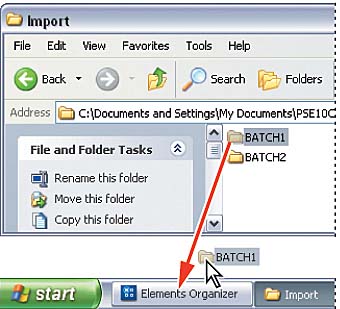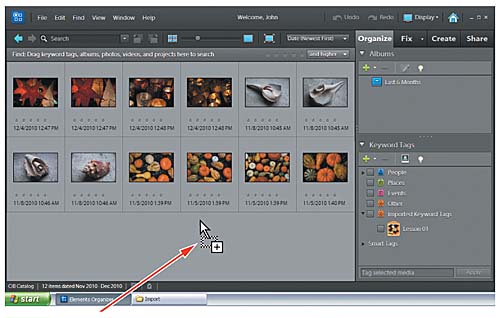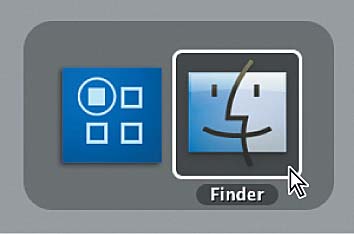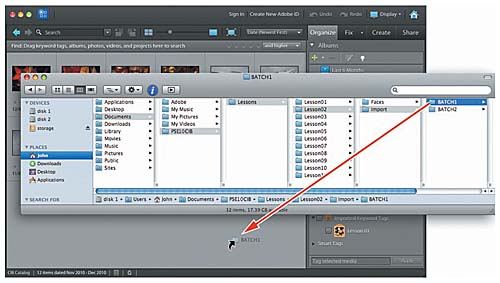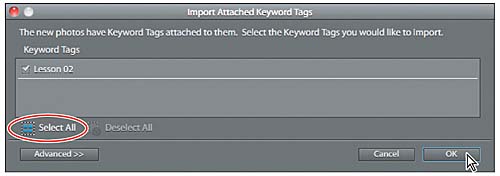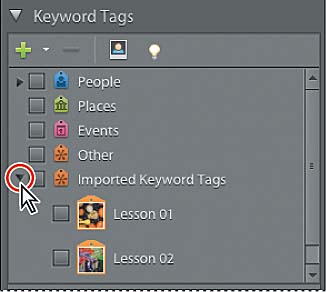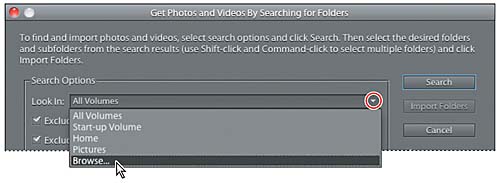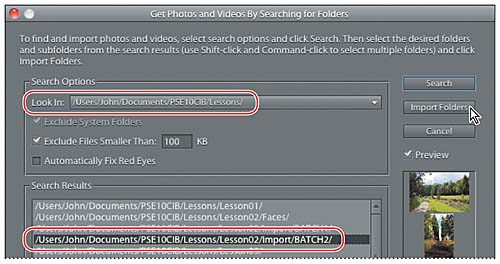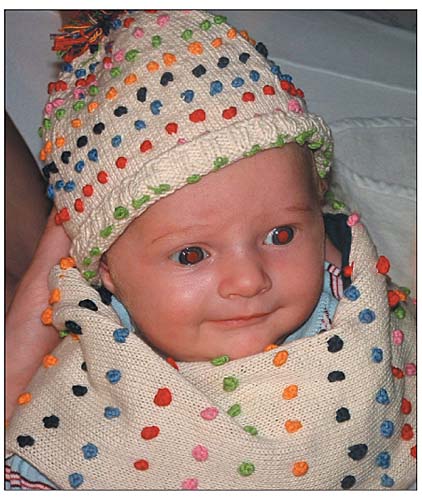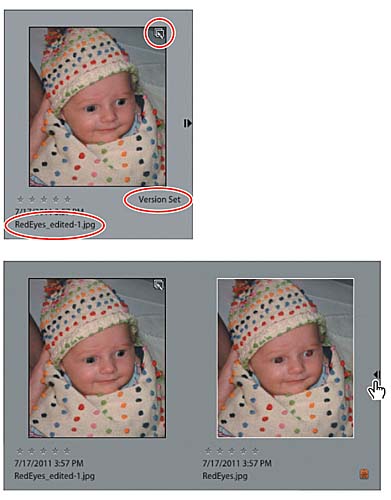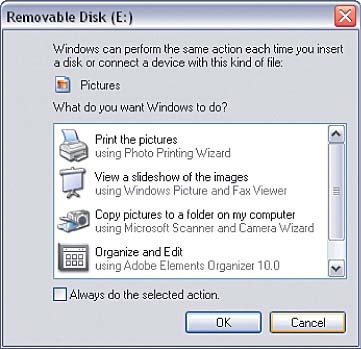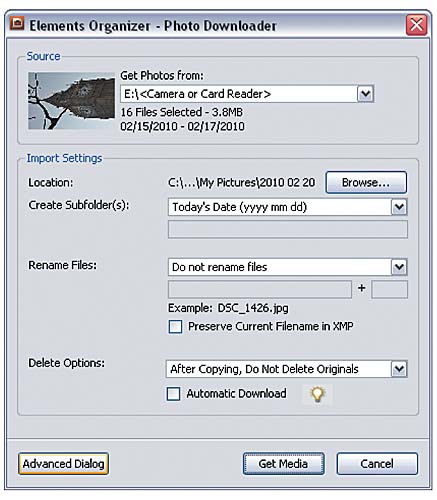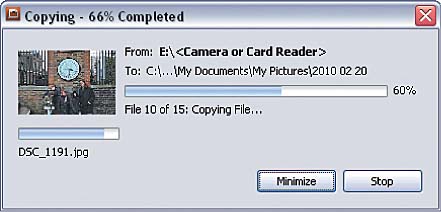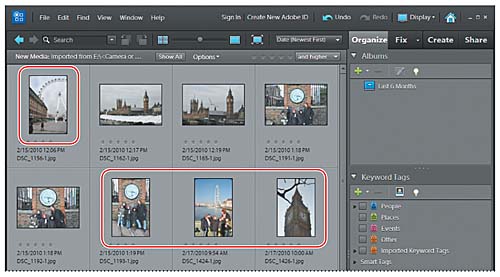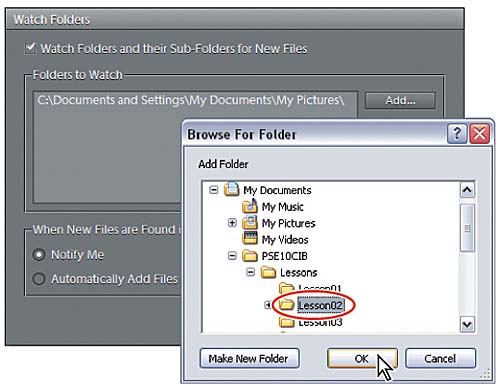Getting photos
The Elements Organizer provides a workspace where you can view, sort and organize your media files. Before you process, print, or share your photos, the first step is to assemble them in the Organizer. In the following exercises you’ll import the images for this lesson into your new catalog using a variety of different methods.
Perhaps the most direct and intuitive way to bring media files into the Organizer and add them to your catalog is to use the familiar drag-and-drop method.
Dragging photos from Windows Explorer
- Minimize the Organizer by
clicking the Minimize button
(
 )
at the right of the Organizer
menu bar, or simply click
the Elements Organizer application
button on the Windows taskbar.
)
at the right of the Organizer
menu bar, or simply click
the Elements Organizer application
button on the Windows taskbar. - Open the My Computer window in Windows Explorer; either double-click a shortcut icon on your desktop, or choose My Computer from the Start menu.
- Locate and open the Lessons folder that you copied to your hard disk. Open the Lesson02 folder, and then the sub-folder named Import.
- Inside the Import folder you’ll find two sub-folders: drag the BATCH1 subfolder and hold it over the Elements Organizer application button on the Windows taskbar.
- Wait until the Organizer becomes the foreground application; then, drag the BATCH1 folder onto the Media Browser pane in the Organizer and release the mouse button. Skip to “Importing attached keyword tags” on the next page.
Dragging photos from the Mac OS Finder
- There are several ways to switch to the Finder on Mac OS. For this exercise, we’ll use the Application Switcher. Hold down the Command key; then, press and release the Tab key. Continuing to hold down the Command key, click the Finder icon; then, release the Command key.
- In the Finder, press Command+N to open a new Finder window. Navigate to and open the Lessons folder that you copied to your hard disk. Open the Lesson02 folder, and then the sub-folder named Import.
- Inside the Import folder are two sub-folders: BATCH1 and BATCH2. If necessary, move the finder window enough to see the Elements Organizer workspace behind it; then, drag the BATCH1 subfolder onto the Media Browser pane and release the mouse button.
- Photoshop Elements briefly displays a dialog box while searching inside the BATCH1 folder for files to import; then, the Import Attached Keyword Tags dialog box opens. Click the Organizer workspace to bring it back to the front.
Importing attached keyword tags
Whenever you import photos that have already been tagged with keywords, the Import Attached Keyword Tags dialog box will appear, giving you the opportunity to specify which tags you wish to import with your images.
- In the Import Attached Keyword Tags dialog box, click Select All; then, click OK.
- The Getting Media dialog box appears briefly as the Organizer imports the images from your BATCH1 folder. If a message appears telling you that only the newly imported items will be visible in the Media Browser, click OK. Thumbnails of the images you just imported appear in the Media Browser.
- Each thumbnail is displayed with an orange tag icon indicating that the image has keywords attached. Hold the pointer over the tag icon at the lower right of any image cell in the Media Browser to see a tooltip listing attached keywords.
- If necessary, click the small triangle to expand the Imported Keyword Tags category in the Keywords Tags panel to the right of the Media Browser; you can see that the newly imported Lesson 02 tag is nested inside, together with the keyword that you imported in the previous lesson.
Searching for photos to import
This import method is useful when you’re not sure exactly where on your hard disk you’ve stashed your photographs and other media files over the years.
You could run a search of your entire hard disk, or just search your My Documents folder, but for the purposes of this exercise, you’ll limit the search to just a small branch of your folder hierarchy.
- In the Organizer, choose File > Get Photos And Videos > By Searching. Under Search Options in the Get Photos And Videos By Searching For Folders dialog box, choose Browse from the Look In menu.
- In the Browse For Folder / Select Folder For Search dialog box, locate and select your Lessons folder, and then click OK.
- Under Search Options in the Get Photos And Videos By Searching For Folders dialog box, make sure the Automatically Fix Red Eyes option is disabled; then, click the Search button located at the upper right of the dialog box.
- The Search Results box lists all folders inside the Lessons folder. Select the folder Lessons/Lesson02/Import/BATCH2. The preview pane at the right shows thumbnails of the contents of the selected folder. Click Import Folders.
- In the Import Attached Keyword Tags dialog box, click Select All, and then click OK. Click OK to close any other alert dialog box.
Automatically fixing red eyes during import
The term “red eye” refers to the phenomenon common in photos taken with a flash, where the subject’s pupils appear red instead of black. This is caused by the flash reflecting off the retina at the back of the eye. In most cases, Photoshop Elements can successfully remove the red eye effect automatically during the import process, saving you the effort of further editing.
- If you don’t see the image file names displayed below the thumbnails in the Media Browser, choose View > Show File Names.
- Double-click the photo RedEyes.jpg to see the enlarged single image view. As you can see, the red eye effect is very pronounced in this flash photograph.
- Double-click the enlarged image to return to the thumbnail display in the Media Browser. With the image RedEyes.jpg still selected, choose Edit > Delete From Catalog. In the confirmation dialog box, make sure that the option Also Delete Selected Item(s) From The Hard Disk is disabled, and then click OK.
- Choose File > Get Photos And Videos > From Files And Folders. In the Get Photos And Videos From Files And Folders dialog box, navigate to and open the BATCH2 folder; then, click once to select the image RedEyes.jpg. Activate the option Automatically Fix Red Eyes, and then click Get Media. In the Import Attached Keyword Tags dialog box, select the Lesson 02 tag; then, click OK. Dismiss any other alert dialog box.
A thumbnail of the newly imported image appears in the Media Browser. Photoshop Elements has stacked the corrected photo with the original in a Version Set, with the edited version on top; the filename has been extended to indicate that the photo has been edited.
You can identify a Version Set by the badge in the upper right corner of the thumbnail and the label below the lower right corner. You’ll learn more about working with Version Sets in Lesson 3.
- Click the arrow at the right of the thumbnail once to expand the Version Set, and again to collapse it.
- Double-click the edited photo to see it enlarged in the single image view.
- To display all of the images that you’ve imported during this lesson, click the find box beside the Lesson 02 tag listed under Imported Keyword Tags in the Keyword Tags panel.
Importing from a digital camera
If you have a digital camera or memory card at hand with your own photos on it, you can step through this exercise using those images. Alternatively, you can skip to the next section of this lesson and return to this exercise when you are prepared.
- Connect your digital camera or card reader to your computer, following the manufacturer’s instructions. If you’re working on Mac OS, skip to step 3.
- On Windows, the Auto Play dialog box may appear. You could choose the option Organize And Edit Using Adobe Elements Organizer 10, but for the purposes of this lesson, simply click Cancel to dismiss the dialog box. If the Photo Downloader dialog box appears automatically, you can skip to step 4; otherwise, continue to step 3.
- Choose File > Get Photos And Videos > From Camera Or Card Reader.
- In the Photo Downloader dialog box, choose the name of your connected camera or card reader from the Get Photos From menu.
- Accept the default target folder listed beside Location, or click Browse / Choose to designate a different destination for the imported files.
- From the Create Subfolder(s) menu, choose Today’s Date (yyyy mm dd) as the folder name format; the Location path reflects your choice.
- Choose Do Not Rename Files from the Rename Files menu. From the Delete Options menu, choose After Copying, Do Not Delete Originals. If you’re working on Windows, deactivate the Automatic Download option.
- Click the Advanced Dialog button. In advanced mode, the Photo Downloader Dialog displays thumbnail previews of all the photos on your camera’s memory card, and also offers options for processing, tagging, and grouping your images.
- If there is a photo on your camera that you wish to exclude from the selection to be imported, click the check box below its thumbnail to remove the check mark.
- If you see a photo that needs to be rotated, select its thumbnail, and then click the appropriate Rotate button in the lower left corner of the dialog box.
- Under Advanced Options, make sure that the Automatically Fix Red Eyes, Automatically Suggest Photo Stacks, Make ‘Group Custom Name’ A Tag, and Import Into Album options are disabled.
- Click Get Media. The selected photos are copied from the camera to the specified folder on your hard disk. By default, images imported from a camera will be copied to your My Pictures / Pictures folder.
- In the Files Successfully Copied dialog box, click Yes. Click OK to close any other alert dialog box.
The imported photos appear in the Media Browser, already rotated where specified.
Using watched folders on Windows
Watched folders are not supported for Mac OS; if you’re working on Mac OS, you can skip to “Viewing photo thumbnails in the Organizer” on the next page.
On Windows, you can simplify and automate the process of keeping your catalog up to date by using watched folders. Designate any folder on your hard disk as a watched folder and Photoshop Elements will automatically be alerted when a new file is placed in (or saved to) that folder. By default, the My Pictures folder is watched, but you can set up any number of additional watched folders.
You can either choose to have any new files that are detected in a watched folder added to your catalog automatically, or have Photoshop Elements ask you what to do before importing the new media. If you choose the latter option, the message “New files have been found in Watched Folders” will appear whenever new items are detected. Click Yes to add the new files to your catalog or click No to skip them.
In this exercise you’ll add a folder to the watched folders list.
- Choose File > Watch Folders.
- Under Folders To Watch in the Watch Folders dialog box, click Add, and then browse to your Lesson02 folder.
- Select the Lesson02 folder and click OK.
- Ensure that the Notify Me option is activated, and then click OK to close the Watch Folders dialog box.
The Lesson02 folder now appears in the Folders To Watch list. To stop a folder from being watched, select it in the list, and then click Remove.
